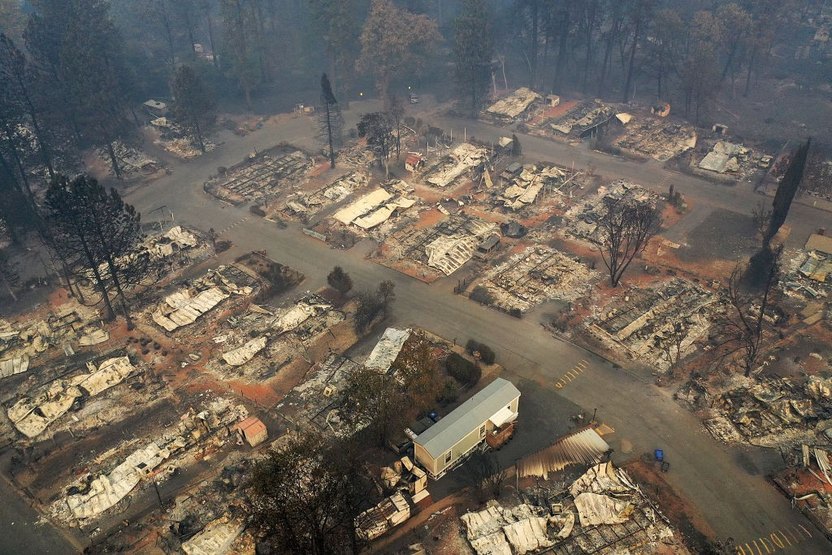California Will Force Insurers To Cover Fire-Prone Areas—but More Costs Will Be Piled Onto Homeowners


David McNew/Getty Images
California will soon force insurance companies that stopped providing coverage over growing wildfire risks to start writing policies again if they want to continue doing business in the Golden State—but it’ll come at a cost for homeowners.
Under a new state regulation unveiled on Monday by the California Department of Insurance, insurers will be allowed to pass the costs for the coverage in California’s fire-prone areas on to their customers, the Associated Press reports.
The rule will require insurance carriers to start boosting their coverage in the wildfire-plagued state by 5% every two years until they reach the equivalent of 85% of their statewide market share.
In other words, if an insurer holds 20 out of every 100 policies in California, 17 of them would have to be in disaster-prone areas, Insurance Commissioner Ricardo Lara’s office said in a statement.
The rule change comes after major insurers, including Farmers Insurance, Allstate, USAA, and The Hartford, previously declared a pause on issuing new policies to homeowners in California. State Farm halted the sale of insurance for new homes in the state last summer and is pursuing rate increases of up to 52% for certain residential policies.
At least 44.8% of all homes in the U.S. are at risk of severe or extreme damage from environmental threats, according to a Realtor.com® report. Almost $22 trillion in residential real estate is in danger of flooding, wind damage, wildfire, heat, or hazardous air quality.
In California, wildfires have burned more than a million acres this year alone, and real estate experts say a lack of insurance coverage has killed at least 13% of deals.
“Insurance in fire-prone areas is increasingly becoming very difficult to obtain,” says Cara Ameer, a real estate agent with Coldwell Banker in Los Angeles. “This is affecting the values of homes in fire zones, since prices are being reduced due to buyer hesitancy and concerns.”

Josh Edelson/AFP via Getty Images
Insurers now forced to write policies in fire-prone areas will be allowed to charge customers a premium to cover their reinsurance costs. The way it works is insurance providers typically buy reinsurance to avoid paying out huge sums in case of a natural disaster, such as a wildfire or a flood.
Lara’s office pointed out that California is the only state in the U.S. that does not already let the costs of reinsurance be passed on to customers.
While Lara touted the passing of the new regulation as “a historic moment for California” aimed at ensuring that the insurance market “doesn’t retreat from communities most vulnerable to wildfires and climate change,” not everyone agrees.
Consumer Watchdog, a California-based advocacy group, warned that the new rule could lead to a 40% to 50% hike in home insurance rates, without requiring insurers to churn out new policies fast enough to meet the high demand.
“This plan is of the insurance industry, by the insurance industry, and for the industry,” Jamie Court, president of Consumer Watchdog, said in a statement.
The regulation will go into effect within 30 days pending a review by the Office of Administrative Law. The California Department of Insurance did not provide a cost analysis of how it could affect consumers and did not offer an opportunity for public comment.
Earlier in December, Lara’s office introduced another rule that would allow insurance companies to factor in climate change when setting their rates.
Insurers previously complained that because they were not allowed to take into consideration the effects of climate change, many companies balked at writing new policies in California, where monster wildfires have become increasingly common in recent years.
California has seen some of the most devastating wildfires in the past decade. Last year alone, more than 8,000 wildfires smoldered through about 1 million acres of land across the nation’s most populous state, according to data from the California Department of Forestry and Fire Protection.
In 2018, the deadly Camp Fire in Paradise, CA, killed 85 people and scorched about 11,000 local homes. Some of the residents who remained in town have found it impossible to buy home insurance, and instead were forced to enroll in the California Fair Access to Insurance Requirements (FAIR) Plan.

Justin Sullivan/Getty Images
The FAIR Plan has emerged as a last resort for homeowners who are otherwise unable to find an insurance company willing to offer them a policy because of the high wildfire risk where they live.
The broader aim of the Insurance Committee’s new rule is to get as many homeowners as possible out of the FAIR Plan, which currently holds around 425,000 policies, up 50% since 2020.
One of those policyholders is Steve Crowder, the mayor of Paradise, who saw both his home and business go up in flames in 2018. Crowder told the AP that his family have been unable to find insurance for their rebuilt home and had no choice but to enroll in the FAIR Plan to the tune of $5,000 per year.
Despite the high annual rate, the town’s mayor said his home is insured about $100,000 less than its value.
Others have it worse still, having to shell out as much as $20,000 a year for some of the larger homes, or give up on coverage altogether.
Categories
Recent Posts










"My job is to find and attract mastery-based agents to the office, protect the culture, and make sure everyone is happy! "
1637 Racetrack Rd # 100, Johns, FL, 32259, United States
